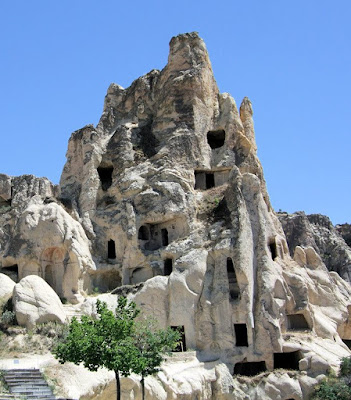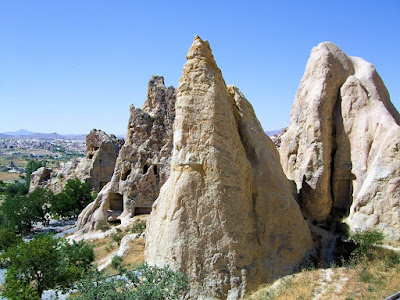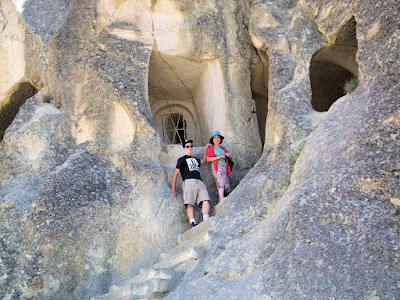
By Keelin Curran
All This Is That History and Archeology Editor
Turkey is in ruins, and fully alive at the same time. I love ruins, and did not fully realize when we selected this destination for our trip exactly how much in heaven I would be here tramping around the churches, columns and caves.

A salvaged frieze from the Temple of Afrodesias

Aphrodite (aka Venus) herself, from the Afrodesia Musem of statuary, friezes, etc. Click to enlarge.
In college, one of my sidelines was Greek archeology. I even took a few semesters of Ancient Greek. On one of our earlier trips to Greece, I tracked down a just-discovered (1979) Minoan temple site destroyed by an earthquake in 18th century BC—Anemospilia—see http://www.uk.digiserve.com/mentor/minoan/anemospilia.htm based on the xeroxed information my professor at Hunter College (whose name I don’t recall, but who was an acolyte of renowned Greek archeologist Emily Vermeule) had handed out to the class.

The gate to the Temple of Aphrodite. Click to enlarge.

A close-up of the gates. Click to enlarge.
I travelled by bus, and tramped around the hills near Iraklion to find it. It was not much—just three rooms you could imagine based on the stone foundations, but they had done sacrifices there that brought the place to life—and death--as this passage describes:

Del Brummet ponders a statue of a philosopher in the excellent Afrodesias Museum. Click to enlarge.
“The west room is, in many ways, the most interesting. . . . [t]his room was used for blood sacrifices. Uniquely in Crete, three skeletons were found in the room. Two of these people, a man and a woman, had been killed by the earthquake and resulting fire. Another male skeleton was also found in the room. This body was found lying on an altar. A knife was resting on the skeleton. The feet had been tied and it has been argued that the young man had been sacrificed and the blood drained from his body. If so, it might well have been his blood in the vessel found in the antechamber next to the skeleton. It is most likely that the normal victims of sacrifice would have been bulls, but in the face of seismic activity which threatened the whole community, it may have been considered necessary to make a human sacrifice.”

Colum Brummet emerges from the gladiator's tunnel at the vast 30,000 seat stadium at Afrodessia. Click to enlarge.
This is about as dramatic as it gets in the ruins world, but well illustrates the open-ended speculation (along with tolerance for sifting and digging) required to do this work.

The 30,000 seat stadium & gladaiatorial venue at Afrodesia.
Anyway, since that 1982 trip to Anemospilia, I haven’t been able to indulge my ruins interest until the last few weeks. The family has been most accommodating in patiently going along on trips to see Agia Sofia in Istanbul, (not a ruin, an amazing, living space from 6th C BC but still a lasagna of one culture on top of another, as ruins often are), the cave dwellings and churches of Goreme, and more recently, the ruins riot that is Ephesus, and most dreamily, the ruins of Afrodisias.
I barely know where to start in talking about these experiences. Goreme and Cappadocia were the most mysterious and humbling. These cave refuges of troglodytes and early Christians were often built at great heights above the current ground level—or far below ground. How did they get up there? How did they tolerate long seasons underground? You have a sense about how scared these people must have been, much of the time, threatened by Hittites and Romans et al. The spaces are so small. They would have known everything about each other—a contrast from our life of screens and large dwellings. And the simple, repetitive and sometimes beautiful scenes of the life of Christ in these churches give one the sense of how much reinforcement is necessary to start a religion from the ground up.

Jack in the Bouletarian theatre that served as the ruling council's meeting place as well as a theatre and performance space.
Then, Ephesus and Afrodisias. These two cities give a living sense of Roman life, in its beauty and brutality. The museum near Ephesus had a riveting exhibit on gladiator culture in ancient Rome, complete with an analysis of the wounds suffered by gladiators based on the skeletal evidence. This culture existed among the beautiful marble buildings and statues; blood and circuses and Ridley Scott/Russell Crowe. Yet you can not help but compare the artistry born of imperial ego, politics, wealth and will in these urban spaces with those we inhabit and find our world poverty-stricken in comparison.
At Afrodisias, up until the last few decades, the town of Gehre was built right on top of Afrodisias. Townspeople built there modest houses braced by the bottoms of roman columns, and crushed their grapes in roman baths. The Temple of Aphrodite, unreconstructed, was a field for their livestock. Seeing the pictures of Gehre (since moved a few kilometers, sadly, to allow the excavation) gives one the sense of how we are just the latest layer in this earth lasagna.
Okay, I will stop. Thanks to you All This Is That readers for indulging me in this Turkey travelogue. We have more ruins to go, so life is very, very good for that reason and all the others that make travel so great.
---o0o---



























